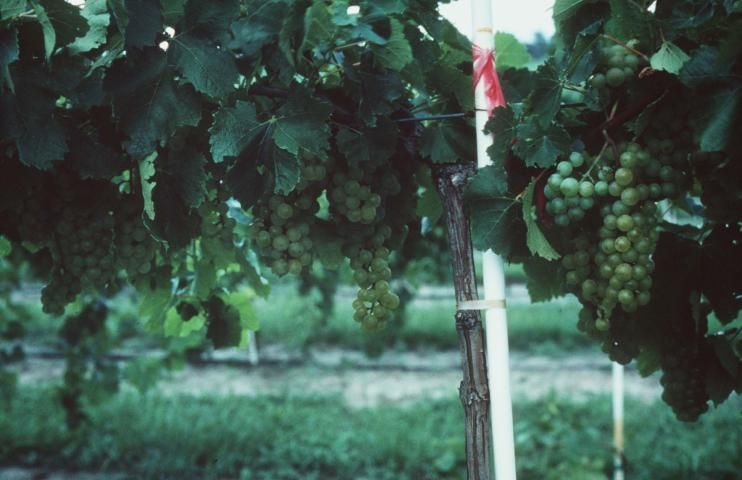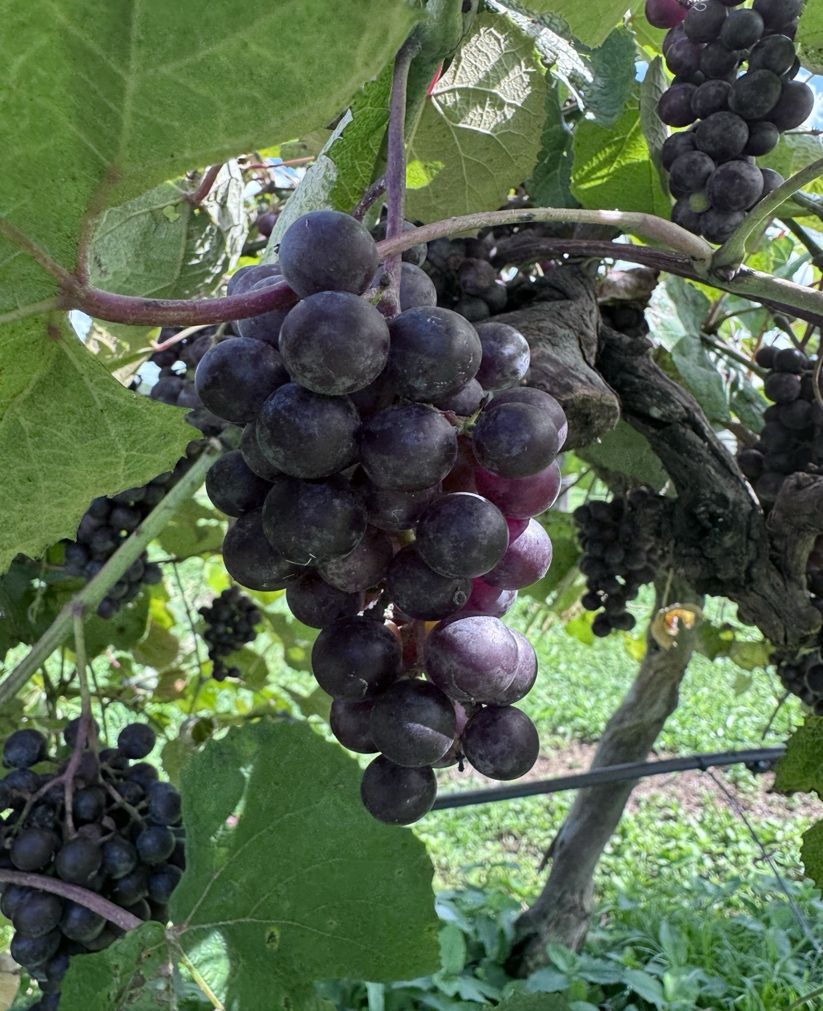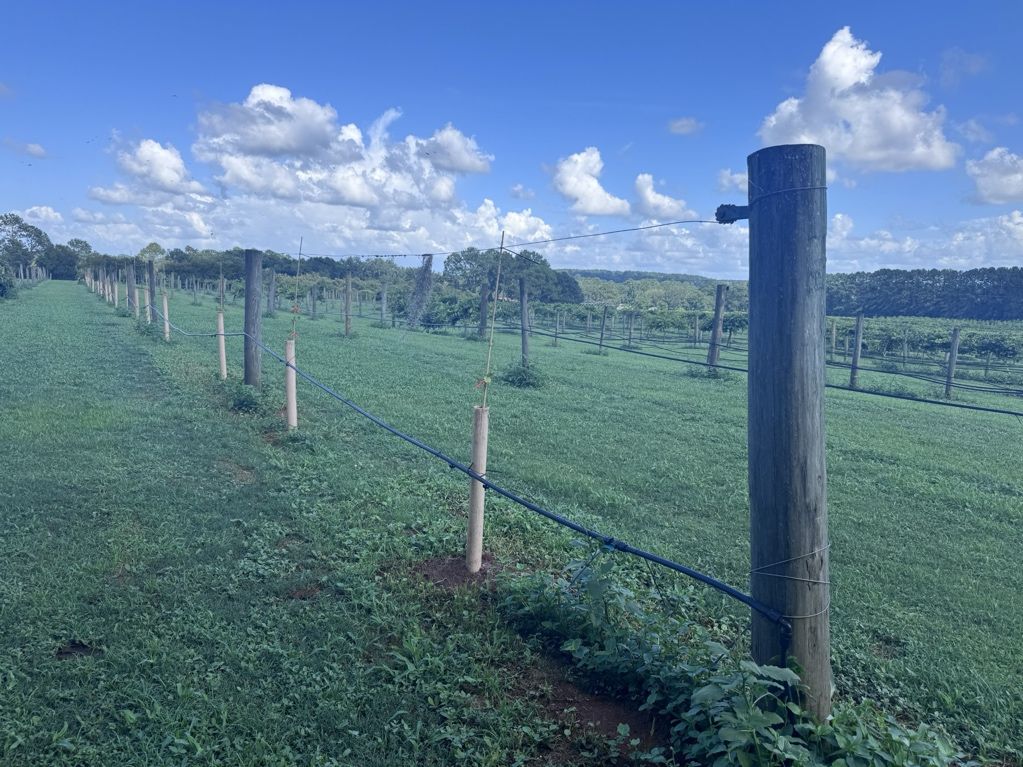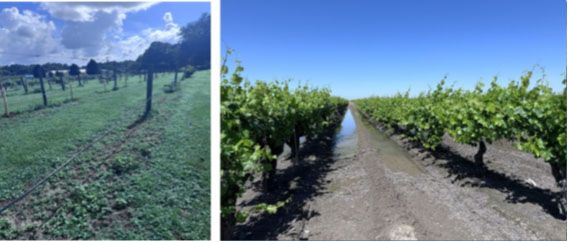Introduction
Bunch grapes, scientifically known as ‘Vitis vinifera,’ are the variety of grapevine that produce grapes in the form of cluster, which are primarily used as fresh, dried and/or in wine production. Bunch grapes were raised in Florida many years ago, but the industry was devastated by Pierce's disease. Pierce's disease is caused by the xylem limited bacterium Xylella fastidiosa. Leafhoppers that feed on xylem fluid spread the disease from plant to plant. Only with the development of Pierce's disease-resistant varieties adapted to Florida's warm, humid climate have bunch grapes been grown successfully in Florida.

Credit: P. C. Andersen, UF/IFAS
Varieties
The University of Florida's Agricultural Research Center at Leesburg and Apopka has had a breeding program for bunch grapes, resulting in the development of several bunch grape varieties. Resistance to Pierce's disease has been the major selection criterion.
The principal cause of poor results with bunch grapes in Florida is the prevalence of fungal diseases during hot, humid growing conditions during the summer. There are only seven varieties currently recommended that have Pierce's disease resistance to do well in Florida. They are best suited for the purposes reported in Table 1.
Table 1. Bunch grape varieties adapted to Florida.

Credit: M. A. Shahid, UF/IFAS
All the varieties are self-fertile and so will bear full crops without another variety as a pollenizer. 'Conquistador', 'Orlando Seedless', 'Black Spanish', and 'Stover' require grafting on 'Tampa' or 'Dog Ridge' rootstocks for satisfactory growth and yields. The other varieties do not require grafting except in areas where the soil pH normally exceeds 7.0. 'Dog Ridge' is the best rootstock to graft them on under alkaline soil conditions.
'Liberty', formerly recommended, has given problems with Pierce's disease and uneven ripening of berries on the bunch. 'Roucaneuf', also formerly recommended, has lacked fruit quality in comparison to the recommended bunch grapes. 'Black Spanish' is resistant to Pierce's disease, although it produces berries with a low sugar:acid ratio. Although 'Orlando Seedless' and 'Norris' are resistant to Pierce's disease, they both can incur berry shattering and are very susceptible to anthracnose.

Credit: M. A. Shahid, UF/IFAS
Propagation and Planting
Rooted grape nursery stock is customarily produced from cuttings made in January from 9- or 10-month-old wood. Canes used for hardwood cuttings should be about 12 inches long, with two or more buds, pencil-sized or a little larger in diameter, fairly straight, with green wood throughout their length. The bottom cut should be just below the lowest bud, and the top cut 1 inch or more above the top bud. The cuttings should be tied tightly in bundles of 50 or less with the bottom ends cut evenly. A cool, shady location should be chosen for the callusing bed. A trench should be dug slightly deeper than the length of the cuttings. The bundles should be placed in an inverted position in one trench and have soil packed firmly around them. Additional soil should be used to provide about 3 inches of cover over the entire bed. Cuttings placed in a bed of this type will callus and start roots in about 6 weeks.
The nursery site should be in a moist location or where water is available. Nursery rows should be far enough apart to accommodate a tractor, and callused cuttings should be set right side up about 9 inches apart in the row. Cuttings should be set with almost the entire length covered with soil and kept moist until they are growing rapidly. Plants will be ready for digging the following winter.
Some bunch grape varieties such as 'Stover' are more productive when grafted on a rootstock. Although several methods of grafting or budding are possible, the cleft graft on one-year-old rootstocks made either in the nursery or in the field is recommended.
Grafting in central Florida should be done around February 1. The rootstocks should be cut off with a saw or sharp shears at a smooth place between nodes about 2 inches above ground level. The stump, if small, should be split with a sharp knife; larger stumps may be split with a grafting tool or chisel.
Budwood for scions should be chosen from healthy vines. A graft scion should be 5 to 8 inches long with a ¼ inch to ½ inch diameter and have 2 or more buds. The portion of the side to be inserted in the cleft should be cut carefully to a long, tapering wedge, preferably slightly thicker on one side. The wedge cut should be inserted carefully into the cleft so that the cambium on its thickest edge and that of the stump match. The pressure of a large stump may hold a scion securely; small stumps should be tied firmly with string or grafting tape.
Grafts are mounded with soil to prevent drying of the scion. The graft should be banked with clean, moist soil up to the top of the scion. Tar-paper cylinders can be placed around the mound to prevent erosion and drying out. During dry periods, watering will be necessary about twice a week. The grafted vine should be trained to a single shoot on a stout, permanent stake attached to the trellis wire.
Where feasible, the rows should be set in a north-south direction so that both sides of the vines will receive sufficient sunlight during the day. The most commonly used spacings and vines per acre are shown in Table 2.
Table 2. Bunch grape planting dimensions.
Transplanting is recommended in late dormancy if the soil moisture is adequate; time of planting will usually be January in south Florida, February in central Florida, and March in north Florida.
The bunch grape should be set at the same depth at which it was growing in the nursery. Grapes can adapt to a wide range of soils, including most of those suited to citrus culture. Fine sands and upland soils, especially those with underlying clay at about 3 feet, are ideal. Soils less adapted to viticulture are the white sands, e.g., St. Lucie, Leon, St. Johns, and Immokalee. Poorly drained soils such as marl, peat, muck, and peaty muck are not recommended.
Growers should avoid planting grapes in pockets that have poor air drainage because late spring frosts may destroy tender shoots and blooms.
Trellising
Trellising the bunch grape is the vital part of its cultivation, which helps the plant in proper canopy management, air circulation, and ease in harvesting. A wire trellis, using number 9 or 10 gauge galvanized steel wire, can be constructed on 8-foot treated posts set 2 feet in the ground. End posts should be 9 feet long and set 3 feet into the ground, with braces to carry a heavy trellis load. Space the posts to accommodate three vines between the posts. The wire should be 6 feet above ground level and stapled to the top center of the post.

Credit: M. A. Shahid, UF/IFAS
Training
The first year, set a 6.5-foot stake by each plant and tie the stake to the top wire of the trellis. As shoots begin to grow from the plant, select the healthiest shoot and secure it to the stake with string or tape. Remove all other shoots. As the selected shoot grows, it eventually becomes the trunk of the vine. It is important to keep it growing straight up the stake by (a) tying with string as needed for support and (b) removing lateral and base sprouts while they are small. Be sure to leave at least one lateral shoot to grow each way along each wire.
Pruning
Pruning is done in Florida during the following dormant periods: (a) south Florida—January; (b) central Florida—January 1 to February 15; and (c) north Florida—January 1 to March 10.
Vines that fail to reach the top wire during the first year should be pruned back to buds near the ground. "Bleeding" of grape vines is not harmful. Vines that reach the top wire during the first year should be pruned to a single cane of 3 to 5 buds along each wire in each direction. After the second year, leave 4 new wood canes (1 for each direction on each wire) with 8 to 12 buds on each cane. The older and more vigorous the vine, the greater the number of buds that can be left on each cane at pruning time. In addition to the 4 canes, leave short 2 or 3 bud spurs near the points of cane origin (near the trunk) for renewal of canes the following year.
Canes are pruned short (3 to 5 buds), and many more canes are left per vine if the "clothesline" trellis is used.
If vines are not pruned at all, the number of clusters will increase, but the size of both clusters and berries will decrease so that only stems and cull berries are produced. Further, the length and width of the vines will make them more difficult to harvest or cultivate.
Fertilization
The pH and nutrient status of the soil should be determined by soil analysis prior to planting. Highly acid soils can be brought to a more desirable level (pH 6.0) by mixing dolomitic limestone in the soil at about 5 pounds/100 square feet of area. The first year, soon after spring growth begins, apply ¼ pound of 6-6-6 or 8-8-8 with 20 to 30% of the nitrogen from natural organic sources, in two lateral bands 1 foot away from the plant. Repeat this application in May, June, and early September. The second year apply 1 pound of the same mixture in February, May, and just after harvest. Rates can be increased in future years but should not exceed 4 pounds per vine per year. Split applications are more efficient than a single application. Weed control is essential to allow maximum benefit to be received from fertilization and irrigation.
Weed Control
Weed control is a critical component of managing bunch grapes, as weeds compete for nutrients, water, and light, and give clear way to pests and diseases. A 4-foot-wide in-row strip should remain weed free with the use of herbicides. Soil cultivation is not recommended since most of the roots of grapevines are very shallow. Cover crops and mulches such as straw, wood chips, etc., may be used to control weeds and conserve moisture. Either black polyethylene, or polypropylene mulches or organic mulches (leaf litter, pine bark, etc.), may be used. Pre- and post-emergence herbicide plan should be adopted to control weeds.
Irrigation
Many first-year grape plants have died in Florida vineyards from lack of soil moisture. Water should be provided when needed; even older plants will respond to irrigation. Creating an effective irrigation schedule for bunch grapes in Florida involves understanding the specific water needs of the grapevines throughout their growth stages and climate conditions. Applications of 1 to 1.5 inches every week during April and May will be sufficient for old vines, but young vines planted in sandy soil may need irrigation every two or three days. Drip irrigation is the highly efficient method to reduce water wastage, and proper water distribution in the plant root zone. For this purpose, drip tubing is suspended alongside the trellis system to ensure delivery of water directly to the root zone of each grapevine. Although about 90% of vineyards used suspended tubing drip system, sub-surface drip system and flooding is also used.

Credit: M. A. Shahid, UF/IFAS
Maturity
The maturity of bunch grapes in Florida depends on several factors, including the grape variety, climate conditions, and vineyard management. In Florida, the grape growing season typically spans from early spring to late summer. Bunch grapes usually mature in late June and July. They should be picked from the vines and stored at 40°F if not processed into jellies, jams, or wine. 'Stover' ripens earliest, followed by 'Blue Lake' and 'Lake Emerald'.
Birds and Other Animal Pests
Birds such as starlings, blackbirds, and sparrows are common pests in vineyards. They can cause significant damage by pecking at grapes, which not only reduces yield but also creates entry points for diseases and pests. If birds are a problem, nylon netting, chicken wire, scare devices, or extermination can be used to control them. Rats, raccoons, and rabbits can usually be controlled by traps or extermination. Proper Integrated Pest Management (IPM) approach should be adopted to overcome this issue.
Management Practices of Pierce's disease
Managing the Pierce's disease in bunch grapes, especially in Florida climate where the disease is prevalent, involves a combination of cultural practices, physical control, and vector control.
Cultural practices include proper pruning of the vineyard to improve health and reduce disease spread. Physical control includes vineyard inspections and testing, pruning out diseased shoots, pulling out entire diseased vines and replacing with varieties less susceptible to disease. Vector control includes trapping and monitoring, insecticide treatments and inspection and removing alternate host plant.
Disease and Insect Control
A spray program for grapes in Florida is advisable to minimize fruit losses. Insecticides can be effective in reducing sharpshooter populations. Systemic insecticides such as imidacloprid and contact insecticides like pyrethroids are commonly used. Spraying should begin when shoots are 3 to 4 inches long and be continued at intervals of 10 days to 2 weeks until 7 to 10 days before harvest. The bloom-time spray is especially important in controlling fruit rots. Black rot and bitter rot can cause damage if vines are not sprayed.